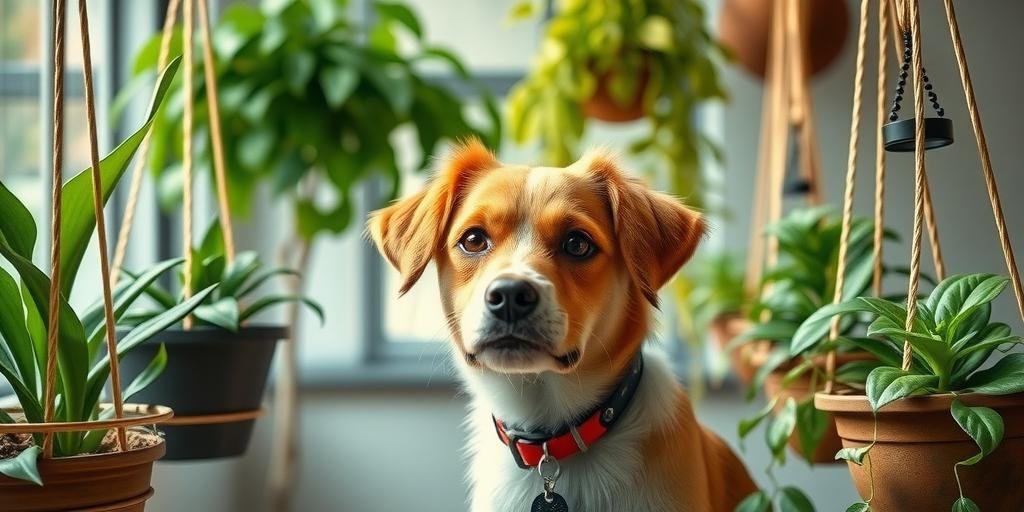
10 Dog-Friendly Low Light Hanging Plants for a Pet-Safe Home
Looking for dog-friendly low light hanging plants? Discover 10 safe, easy-care options that thrive in dim spaces while keeping your furry friend happy and healthy!
Introduction
Did you know that over 65% of pet owners worry about toxic plants in their homes? If you’re a dog parent with a love for greenery, finding the right hanging plants that thrive in low light and are safe for your pup can be tricky. But don’t worry—we’ve got you covered! In this guide, we’ll explore 10 beautiful, non-toxic hanging plants that flourish in low-light conditions, making them perfect for apartments, shady corners, or homes with limited sunlight. Let’s create a lush, pet-friendly indoor jungle together!
Why Choose Dog-Friendly Low Light Hanging Plants?
If you’re a dog owner with limited space, hanging plants can be a game-changer. Not only do they add greenery without taking up floor space, but they also keep your curious pup from digging in the soil or chewing on leaves. Low-light plants are especially useful because they thrive in areas where sunlight is scarce—perfect for apartments or rooms with small windows.
But here’s the catch: not all plants are safe for dogs. Many common houseplants, like pothos or philodendrons, can be toxic if ingested. That’s why choosing dog-friendly varieties is a must. Plus, low-light plants are naturally adapted to survive in dim conditions, making them ideal for indoor environments where natural light is limited.
Benefits of Hanging Plants in Small Spaces
Hanging plants are a smart solution for small homes. They free up shelf and floor space while adding a touch of nature to your decor. For dog owners, elevating plants also means fewer temptations for pets who love to nibble on greenery. Plus, trailing plants like spider plants or Swedish ivy create a beautiful cascading effect, adding visual interest to any room.
Risks of Toxic Plants for Dogs
Dogs are naturally curious, and some can’t resist chewing on leaves or digging in pots. Unfortunately, many popular houseplants contain compounds that can cause vomiting, diarrhea, or even more severe reactions in pets. Before bringing any plant home, always double-check its toxicity level. The ASPCA’s website is a great resource for verifying pet-safe options.
How Low-Light Plants Adapt to Indoor Environments
Low-light plants have evolved to survive under dense forest canopies, where sunlight is filtered through layers of foliage. This makes them perfect for indoor spaces with minimal natural light. They typically have larger, darker leaves that absorb light more efficiently and require less frequent watering than sun-loving plants.
Top 10 Dog-Safe Hanging Plants for Low Light
1. Spider Plant (Chlorophytum comosum)
Spider plants are a top choice for pet owners because they’re completely non-toxic and incredibly easy to grow. They thrive in indirect light and can even tolerate occasional neglect. One of their coolest features? They produce “spiderettes”—little offshoots that dangle from the mother plant, which you can snip and propagate for more free plants!
2. Boston Fern (Nephrolepis exaltata)
If you want lush, feathery foliage that’s safe for dogs, the Boston fern is a winner. It loves humidity, making it a great pick for bathrooms or kitchens. Just keep it out of direct sunlight, which can scorch its delicate fronds.
3. Staghorn Fern (Platycerium bifurcatum)
This fern gets its name from its unique, antler-like leaves. It’s pet-friendly and adapts well to low or medium light. You can mount it on a board or hang it in a basket for a striking display.
4. Peperomia (Peperomia spp.)
Peperomias come in many varieties, all of which are safe for dogs. The Peperomia obtusifolia, or baby rubber plant, is especially hardy and does well in shade. These plants are compact, drought-tolerant, and perfect for small spaces.
5. Swedish Ivy (Plectranthus verticillatus)
Despite its name, Swedish ivy isn’t a true ivy—and it’s non-toxic to pets. It grows quickly, producing long trailing vines that look stunning in hanging baskets. While it prefers bright, indirect light, it can adapt to lower light conditions.
6. Parlor Palm (Chamaedorea elegans)
This elegant palm is safe for dogs and thrives in low light. It’s also tolerant of dry air, making it a great choice for homes with inconsistent humidity. Just be patient—it’s a slow grower.
7. Burro’s Tail (Sedum morganianum – Non-Toxic Varieties)
Some succulents are toxic to pets, but Burro’s Tail (when confirmed non-toxic) is a safe option. Its trailing stems of plump leaves look gorgeous in hanging pots. While it prefers bright light, it can tolerate some shade.
8. Cast Iron Plant (Aspidistra elatior)
True to its name, the cast iron plant is nearly indestructible. It’s safe for dogs, thrives in deep shade, and can handle neglect like a champ. If you’re a beginner or tend to forget about your plants, this one’s for you.
9. Prayer Plant (Maranta leuconeura)
Prayer plants are known for their striking leaf patterns and pet-safe status. They prefer low to medium indirect light and higher humidity, so misting them occasionally helps keep them happy.
10. Friendship Plant (Pilea involucrata)
This plant is safe for dogs and super easy to propagate—hence the name “Friendship Plant.” Its textured leaves add visual interest, and it does well in filtered light.
Caring for Your Dog-Friendly Hanging Plants
Watering Tips for Low-Light Plants
Since low-light plants grow slower, they don’t need as much water as sun-loving varieties. Always check the soil before watering—stick your finger an inch deep; if it’s dry, it’s time to water. Overwatering is a common killer of indoor plants, especially in low light.
Best Soil and Fertilizer Choices
A well-draining potting mix is key to preventing root rot. Look for mixes labeled for indoor plants or succulents, depending on your plant’s needs. Fertilize sparingly—once a month during the growing season (spring and summer) is usually enough.
How to Prevent Pests Naturally
Keep an eye out for common pests like spider mites or mealybugs. Wiping leaves with a damp cloth or spraying them with a mix of water and mild soap can help keep bugs at bay. Neem oil is another pet-safe option for pest control.
Common Mistakes to Avoid
Overwatering in Low-Light Conditions
Less light means slower growth and less water uptake. Overwatering can lead to root rot, so always err on the side of underwatering with low-light plants.
Choosing Toxic Lookalike Plants
Some safe plants have toxic doppelgängers. For example, the non-toxic hoya can be confused with toxic wax plants. Always verify a plant’s identity and safety before bringing it home.
Ignoring Humidity Needs
Many low-light plants, like ferns and prayer plants, thrive in humid environments. If your home is dry, consider misting them regularly or placing a humidifier nearby.
By choosing the right plants and caring for them properly, you can create a lush, pet-friendly indoor jungle—even in the darkest corners of your home.
Conclusion
Transforming your home into a pet-safe, plant-filled oasis is easier than you think! With these 10 dog-friendly low light hanging plants, you can enjoy lush greenery without compromising your pup’s safety. Whether you opt for a Spider Plant’s cascading leaves or a Boston Fern’s feathery fronds, there’s a perfect match for every space. Ready to get started? Pick your favorites, hang them up, and watch your indoor garden thrive—all while keeping your furry best friend happy and healthy!
